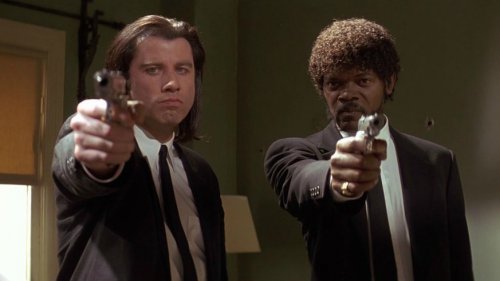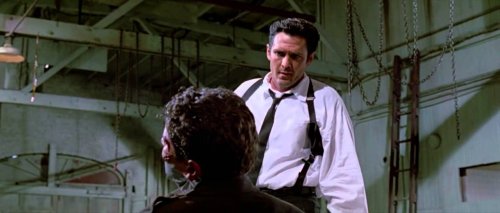Quentin Tarantino and His Taste for Violence

Quentin Tarantino is a director who has managed to create his own brand. When we go see one of his films, we know it’s going to have violence, music, fetish actors, close-ups of female feet, and plenty of tributes, among other things. Tarantino loves things such as tributes to filmmakers like Alfred Hitchcock, kung-fu movies, spaghetti westerns, and even The Flintstones.
Tarantino does what he wants. He makes cameos, plays with color, and recycles plans. He reinvents scenes and mixes everything until he finds what he’s looking for. Many people accuse him of plagiarism, although he’s admitted that he’s inspired by other films.
Everyone takes advantage of their tastes and influences and uses them for their benefit. Hence, when creating something completely new in the XXI century, we’re almost always “copying” or adapting something that has already been done.
On more than one occasion, he’s pointed out that an individual doesn’t have to go to school in order to make good films, they just needed to be passionate about doing so. His passion shows through his films. Now that we’ve said all of this, we must ask: why do we like violence so much? Why are Quentin Tarantino’s movies so special?
The particularities of his films
Quentin Tarantino took acting classes and worked in a video store, a place he said was a source of inspiration for him. The idea of Reservoir Dogs emerged one day while being surrounded by friends. At that time, Tarantino didn’t think it was possible for him to make a real film so he was okay with settling for making a cheap production with his friends. However, the producer Lawrence Bender read his script and gave him the opportunity to make it.
“You don’t have to know how to make a movie. If you truly love cinema with all your heart and with enough passion, you can’t help but make a good movie.”
-Quentin Tarantino-
He pays homage to many movies. Let’s mention some examples of this. The famous Pulp Fiction dance scene was extracted from Fellini’s 8 1/2 and Uma Thurman’s costume in Kill Bill greatly reminds us of Bruce Lee.
Tarantino’s films are all about submerging the viewer in a world of intertextuality. His films have their own plot and identity while, at the same time, are full of allusions and references. After Pulp Fiction (1994), people finally consecrated Tarantino as a director and scriptwriter. He caught the public and the critics’ attention, leading him to win his first Academy Award for Best Original Screenplay.

Other films such as Jackie Brown (1997), Inglorious Basterds (2009), or Kill Bill (2003) ended up founding Quentin Tarantino’s brand. Finally, his latest films Django Unchained (2012) and The Hateful Eight (2015) were a declaration of love for quite a forgotten film genre: spaghetti western. With these films, Tarantino recovered the essence of the genre and filmmakers like Sergio Leone, as well as Ennio Morricone, who composed some of the most recognizable film soundtracks.
Another interesting fact about Tarantino’s films is that he’s also personally responsible for their soundtracks.
On the other hand, anachronism isn’t something that worries Tarantino. He makes all the pieces of the puzzle fit together perfectly in the end.
Quentin Tarantino and his taste for violence
If something defines Quentin Tarantino’s movies, it’s violence. Totally explicit violence and bloodbaths that are sometimes so absurd you can’t help but laugh. One particularity of his films is that there rarely ever are characters to sympathize with, which ends up making the viewers not care about who lives and who dies. The Hateful Eight is a great example of this.
If you’re about to watch a Quentin Tarantino film, don’t expect to find any endearing characters. Be ready to see blood and violence and laugh along the way.
The funny thing is that despite their disorganized narration and explicit violence, the viewers end up loving his films. The scenes he portrays in his productions are a beautiful art form. The famous ear-cutting scene in Reservoir Dogs, for example, is made unique by its background music and dancing while, at the same time, it was a “replica” of a scene from the movie Django (Corbucci, 1966).

Can violence be something fun? Does it have a limit? Tarantino has said several times that his movies are pure fiction for the viewers to enjoy. Instead of questioning whether his violence is moral or not, we should just enjoy it. The music makes the violence portrayed in Tarantino’s films beautiful and aesthetically pleasing. There’s a clear difference between films that portray violence in a realistic, raw way and those that use violence as another simple excuse for entertainment.
“Violence is one of the most fun things to watch.”
-Quentin Tarantino-
Moreover, Quentin Tarantino has spoken about the fact that kung fu tapes are really violent, but nobody questions their morality because they’re pure entertainment. When it comes to raw, violent films such as The Passion of the Christ (Mel Gibson, 2004), Das Experiment (Oliver Hirschbiegel, 2001), or Irréversible (Gaspar Noé, 2002), the audience won’t feel any pleasure at all, only discomfort.
This doesn’t happen when you watch a film by directors such as Martin Scorsese or Quentin Tarantino. These filmmakers use violence as a cathartic method to portray liberty and purification through images.
Moreover, Aristotle made a few references to violence in his work Poetics. There, he analyzed the Greek tragedies and all that they entailed. Why did the Greeks enjoy seeing violent or incestual scenes? Precisely because they were taboo topics. Nonetheless, they’re characteristic passions that humans tend to repress due to their immoral aspect. Violent shows were cathartic for the Greeks, which is why they enjoyed attending them.
Several psychoanalytic authors such as Freud also delved deep into this topic. He and other experts concluded that the taste for violence seems to be characteristic of human beings, something that, in one way or another, we’ve tried to shape into an art.
Quentin Tarantino always reminds us that his films are nothing more than fantasy. Their unrealistic aspects are precisely what his fans enjoy the most. They’re cathartic, passionate, and emotional. Tarantino’s films are, without a doubt, meant to be enjoyed.
All cited sources were thoroughly reviewed by our team to ensure their quality, reliability, currency, and validity. The bibliography of this article was considered reliable and of academic or scientific accuracy.
- Corral, J.M., (2013): Quentin Tarantino, glorioso bastardo. Palma de Mallorca, Dolmen.
- Serrano Álvarez, A., (2014): El cine de Quentin Tarantino. Caracas, Universidad Católica Andrés Bello.
This text is provided for informational purposes only and does not replace consultation with a professional. If in doubt, consult your specialist.








